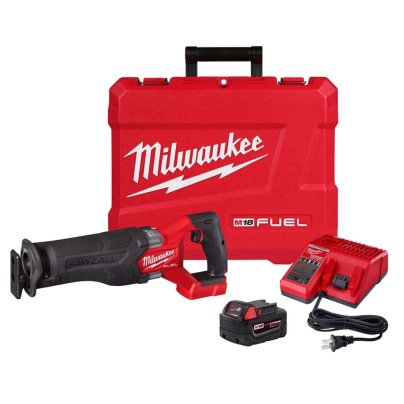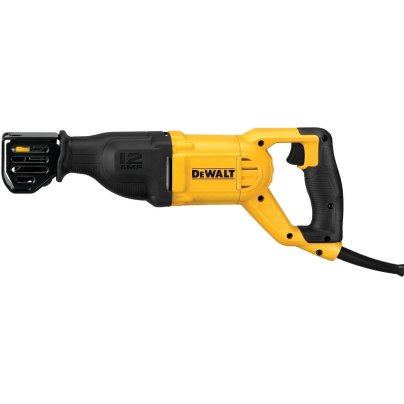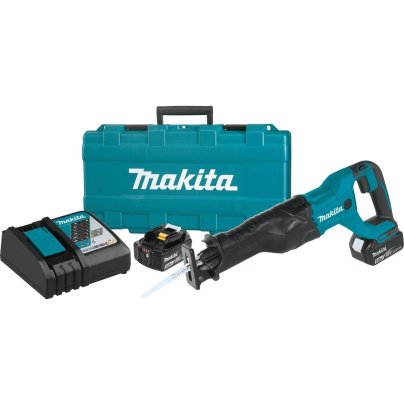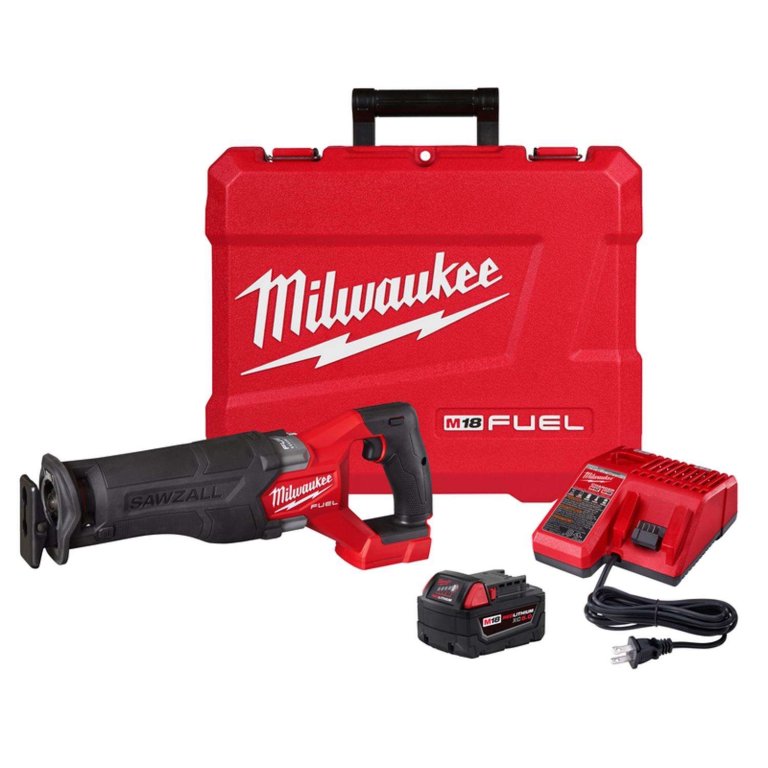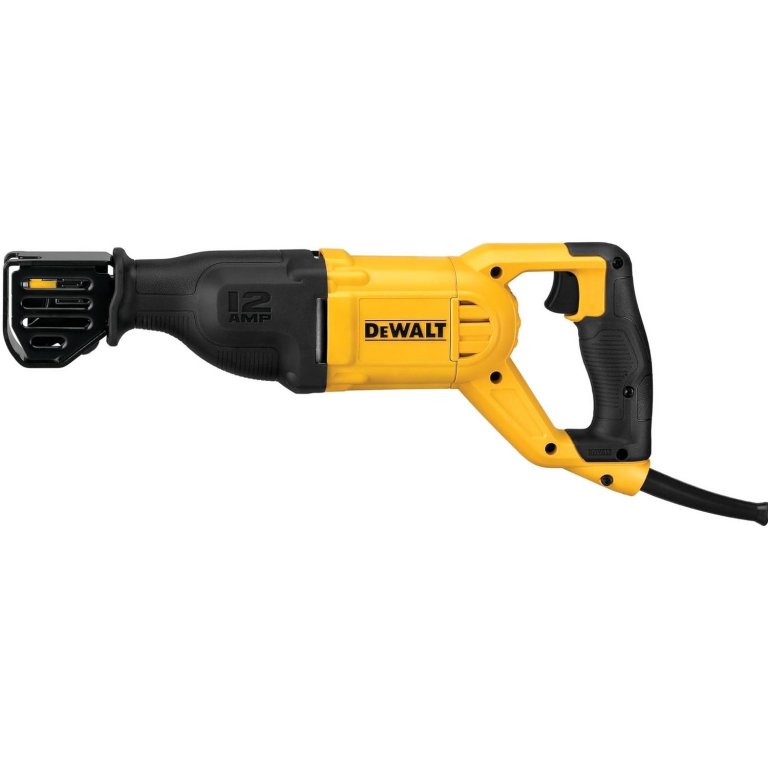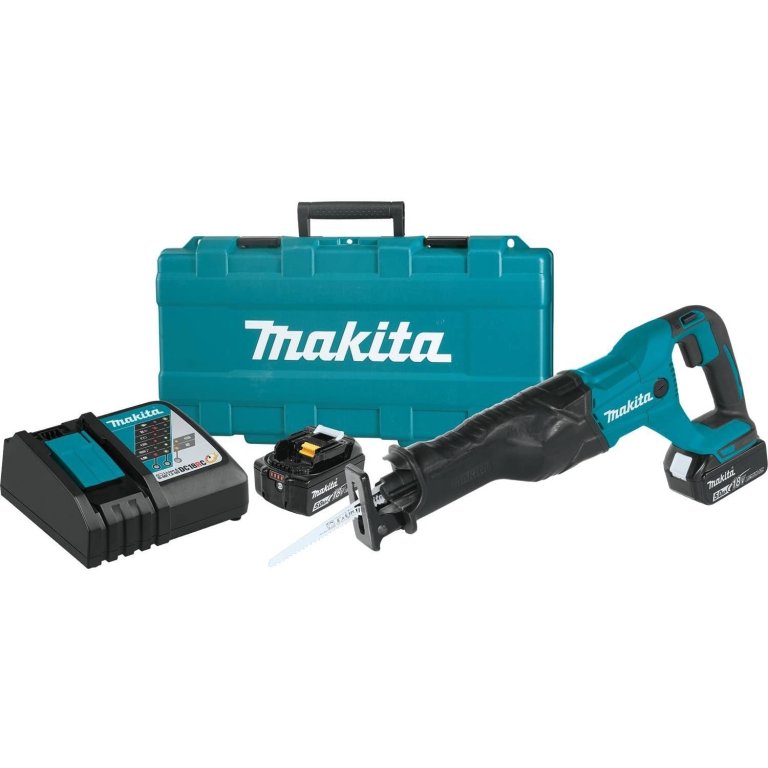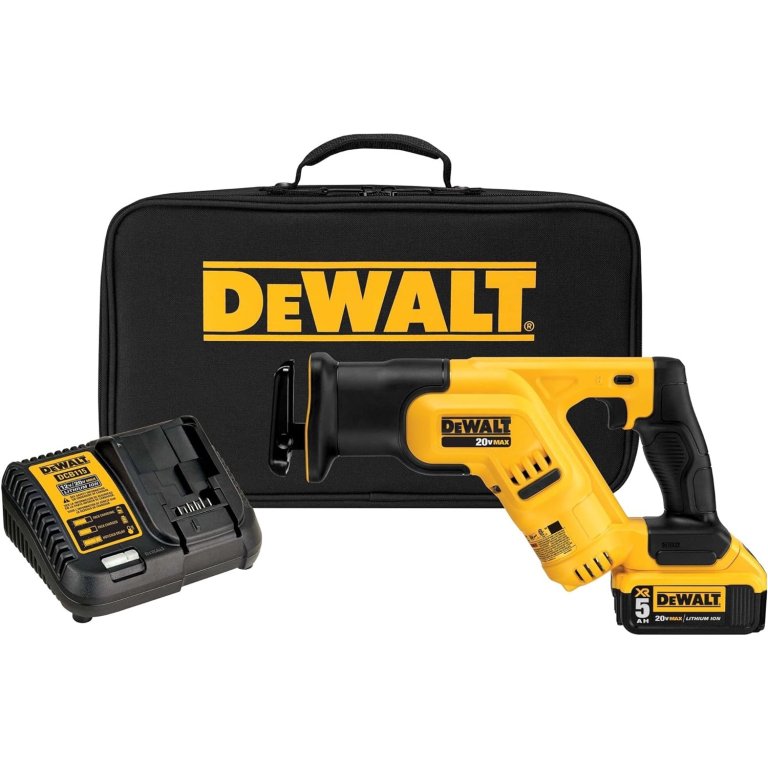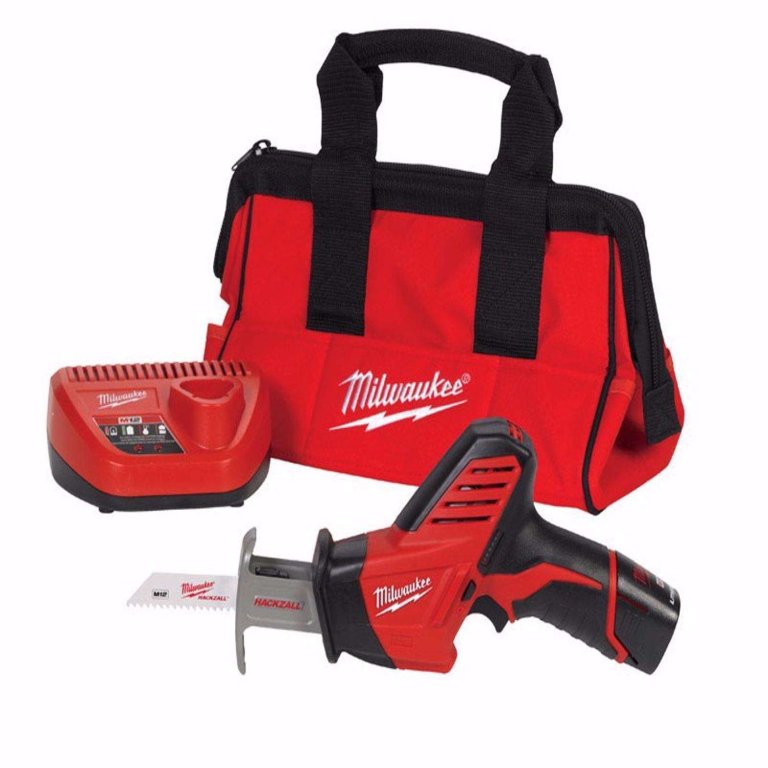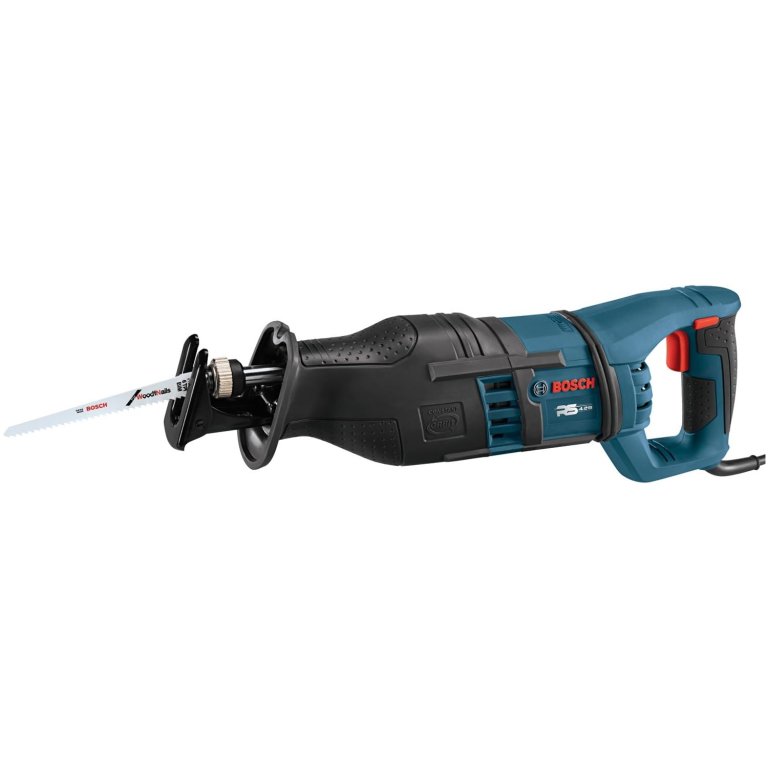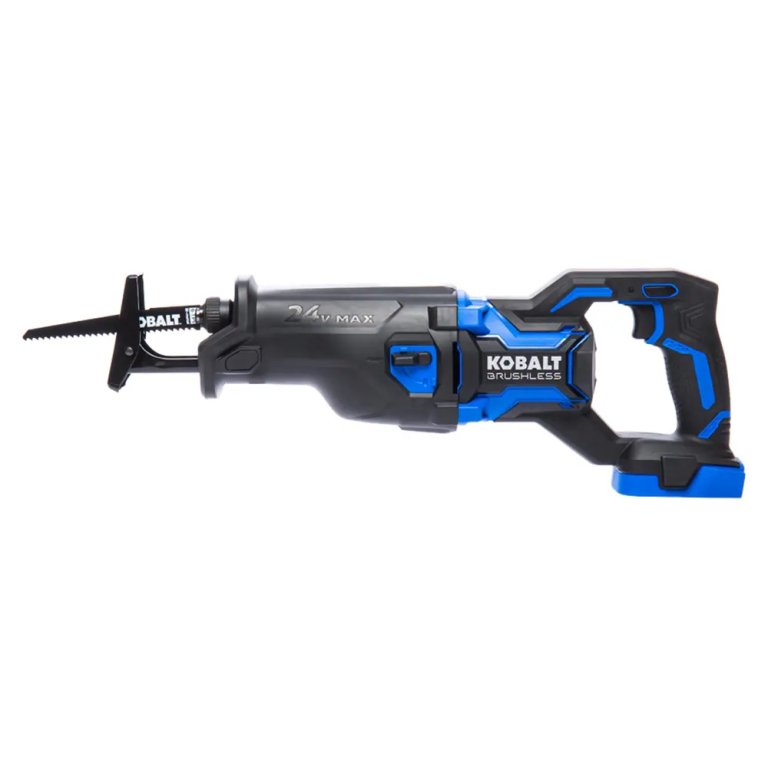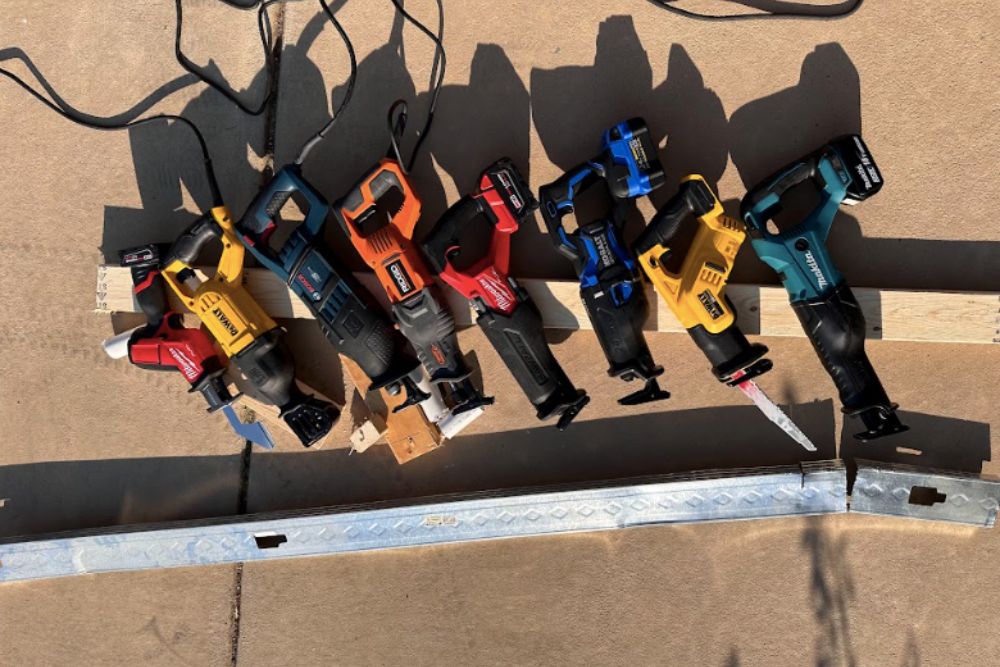
We may earn revenue from the products available on this page and participate in affiliate programs. Learn More ›
Also known as a “recip saw,” a “saber saw,” and a “Sawzall,” the handheld reciprocating saw is the tool of choice for demolition work. Reciprocating saws cut through a variety of materials, including wood and metal. The best reciprocating saw depends on the type of material you need to cut; how often you intend to use it; and, most importantly, the quality of the product you’re searching for.
We recently tested eight different reciprocating saws, using them to cut through wood, plastic, and metal, to discover which ones were the top performers. Once the sawdust cleared, the Milwaukee M18 Fuel Sawzall Reciprocating Saw Kit emerged as the clear winner. Milwaukee’s highest-end reciprocating saw slices quickly and easily through wood, PVC, and metal.
Below, we offer our findings on each of the models we tested and cover what to look for when shopping for the best reciprocating saw.
- BEST OVERALL: Milwaukee M18 Fuel Sawzall Reciprocating Saw Kit
↓ Jump to Review - BEST BANG FOR THE BUCK: DeWalt 12-Amp Reciprocating Saw
↓ Jump to Review - BEST CORDLESS: Makita 18V LXT Lithium-Ion Cordless Recipro Saw Kit
↓ Jump to Review - BEST COMPACT: DeWalt 20V MAX Compact Reciprocating Saw Kit
↓ Jump to Review - BEST FOR YARD WORK: Milwaukee M12 Hackzall Recip Saw Kit
↓ Jump to Review - BEST CORDED: Bosch Vibration Control D-Handle Reciprocating Saw
↓ Jump to Review - BEST POWER: Kobalt XTR 24V Brushless Cordless Reciprocating Saw
↓ Jump to Review
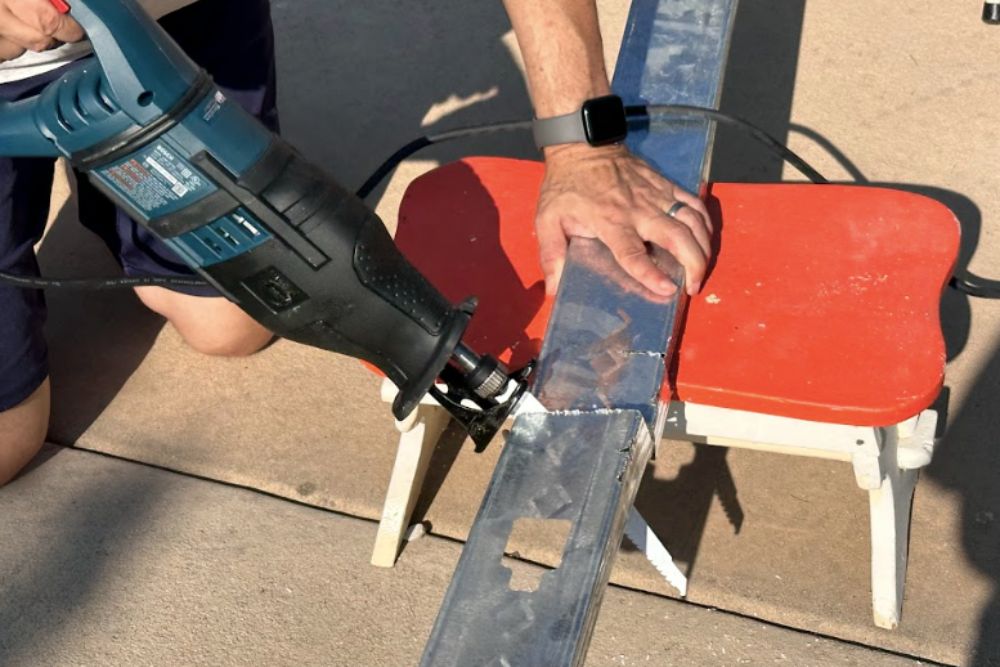
Before You Buy a Reciprocating Saw
If you don’t have construction materials to tear out or cut away, a reciprocating saw might not be a great option for you. Like chainsaws, reciprocating saws can be heavy (up to 10 pounds), and if the tip of a moving blade makes contact with wood or other material, the saw can kick back forcefully, putting the operator at risk of injury.
Plus, reciprocating saws are not designed for making precision cuts, so if you need to cut out a hole in a counter to install a sink, you’ll get a more precise cut by using a router or a jigsaw. Likewise, recip saws cannot make plunge cuts (cuts through the middle of the material). Instead, their blade must make contact with the side of the material in order to start cutting, so to use a recip saw in this situation, you’ll first need to create a pilot hole to insert the recip saw blade or use a different type of saw, such as a jab saw.
How We Tested the Best Reciprocating Saws
We put our reciprocating saws through a series of tests in order to find the top models. We tested for performance by cutting through several materials, including a 2×4, a 1-inch metal pipe, a metal stud, and a 2-inch PVC pipe, timing how long it took the reciprocating saw to cut through the material. We performed no fewer than six cuts with each saw we tested.
We also assessed how easy each saw was to use by loading various types of blades; performing cuts from multiple angles; and considering weight, handle design, and vibration. Finally, we looked at value by comparing prices for each reciprocating saw.
Our selections include both corded and cordless models to suit everything from occasional use around the house to everyday professional use.
| Testing Stats | |
| Products tested | 8 |
| Hours spent testing | 6 hours |
| Tests performed | 6 |
| Price range | $100 to $400 |
Our Top Picks
The following reciprocating saws boast a variety of the key features mentioned above, and each is a standout in its class for power, speed, and durability. The best reciprocating saw for you may well be on this list.
Best Overall
Milwaukee M18 Fuel Sawzall Reciprocating Saw Kit
What We Like
- Stroke length and speed translate to lightning-fast cutting speed
- Low vibration reduces arm fatigue and enhances control
- Kit comes with dual charger and 2 large-capacity batteries
What We Don’t Like
- One of the more expensive reciprocating saws you can buy
Product Specs
- Type: Cordless
- Weight: 7.4 pounds
- Speed: 3,000 strokes per minute (SPM)
- Stroke length: 1⅛ inch
Our Ratings: Ease of Use 5/5; Performance 4.8/5; Build Quality 5/5; Noise 4/5; Value 5/5
There’s the Milwaukee M18 Fuel Sawzall reciprocating saw, and then there’s everyone else. That’s truly what it felt like after testing this model, the premium tool brand’s top-of-the-line reciprocating saw.
This saw dominated our testing. Not only did it produce fantastic power, but it felt smoother than most without the vibration we experienced with other reciprocating saws. It took just 7 seconds to cut clean through a 2×4 and about a second more than that with deck screws embedded into it. It also made quick work of our 2-inch plastic pipe, cutting through it in just 4 seconds, and it was the only saw we tested to cut through our metal stud without a struggle.
In short, the Milwaukee M18 Fuel Sawzall is in another league when it comes to reciprocating saws. Yes, it’s pricey, but it’s not that much steeper than the reciprocating saws we tested from other top-tier cordless tool manufacturers—especially since Milwaukee sweetens the deal by including two large-capacity 5-amp-hour (Ah) batteries.
Other notable features include a retractable hook (which makes storing the M18 Sawzall easier) and a charger that will also take Milwaukee’s smaller 12-volt batteries, which is a great feature if you’re already invested in the Milwaukee family of cordless tools. If you’re going to spend on a cordless reciprocating saw, this is our favorite, hands down.
Get the Milwaukee M18 reciprocating saw at Ace Hardware (1 battery) or The Home Depot.
Best Bang For The Buck
DeWalt 12-Amp Reciprocating Saw
What We Like
- 4 blade positions make cutting from various angles easy
- Affordable yet quality alternative to cordless reciprocating saws
- Low vibration when cutting enhances ease and precision
What We Don’t Like
- Slower blade speed and shorter stroke length extend cutting time
Product Specs
- Type: Corded
- Weight: 7 pounds
- Speed: 2,900 SPM
- Stroke length: 1⅛ inches
Our Ratings: Ease of Use 4.5/5; Performance 3.3/5; Build Quality 5/5; Noise 4/5; Value 5/5
DeWalt’s corded reciprocating saw may not match the performance of the more powerful 15-amp corded reciprocating saws or cordless models out there, but it’s certainly up to the task for most home applications. With its 1⅛-inch stroke length and max 2,900 SPM, it cut through our test 2×4 in about 18 seconds. Plus, it’s less than half the cost of most cordless models and boasts DeWalt’s exceptional build quality.
This model also features a novel blade design that allows you to install the blade vertically or horizontally, making it easy to shift from cutting upwards, downwards, and side to side. The large guard also helped to steady the blade as we were cutting through various materials. And with this vibration damping, we were able to make fairly precise cuts. With a cost of a little over $100, it’s a great value from a brand that’s considered one of the best power tool companies in the business.
Get the DeWalt 12-Amp reciprocating saw at Ace Hardware, Amazon, or The Home Depot.
Best Cordless
Makita 18V LXT Lithium-Ion Cordless Recipro Saw Kit
What We Like
- 2-handed design and ergonomic grip enhance control
- Kit comes with a rapid charger and 2 batteries
- Vibration reduction makes it easier to make smooth cuts
What We Don’t Like
- One of the most expensive reciprocating saws out there
Product Specs
- Type: Cordless
- Weight: 8.3 pounds
- Speed: 2,800 SPM
- Stroke length: 1¼ inches
Our Ratings: Ease of Use 4.5/5; Performance 4.5/5; Build Quality 4.5/5; Noise 4/5; Value 3.5/5
Most reciprocating saws vibrate such that they leave your hand and arm tingling and numb after just a few cuts, but Makita’s 18V LXT is an exception. Of all the saws we tested, it produced the least amount of vibration, cutting smoothly through wood, metal, and PVC.
With its 18-volt brushless motor, 1¼-inch stroker length, and 2,800 SPM speed, it isn’t short on power, either. We cut through a 2×4 in about 8 seconds, putting it on par with some of the fastest reciprocating saws we tested. Cutting through wood with a screw in it was a tick slower, and it struggled a bit with our metal stud, but overall, it was a high performer.
Makita’s tools are known for their ergonomic designs, and this reciprocating saw demonstrates why that is. This saw felt well balanced in our hands, and we appreciated the overmolded handle (which made it easy to grip) and the ample rubberized covering that allowed us to get a firm hold on the saw regardless of what angle we chose to cut from.
We like that Makita includes two large-capacity 5 Ah batteries and a rapid charger, which means you’ll be able to cut almost indefinitely by rotating the batteries. However, this reciprocating saw is among the priciest.
Get the Makita reciprocating saw at Amazon or The Home Depot.
Best Compact
DeWalt 20V MAX Compact Reciprocating Saw Kit
What We Like
- Compact size makes it suitable for hard-to-reach places
- 4-position blade clamp simplifies cutting from different angles
- Similar cutting power to a full-size reciprocating saw
What We Don’t Like
- Considerable vibration complicates 1-handed operation
Product Specs
- Type: Compact/1-handed
- Weight: 5 pounds (without battery)
- Speed: 2,900 SPM
- Stroke length: 1⅛ inches
Our Ratings: Ease of Use 4/5; Performance 4.5/5; Build Quality 5/5; Noise 4/5; Value 4/5
DeWalt managed to make this compact reciprocating saw nearly as powerful as the full-size two-handed cordless models we tested. With its brushless 20-volt motor and battery, it produces a maximum of 2,900 SPM with a 1⅛-inch stroke length. While this wasn’t powerful enough to cut at the same rate as the top performers on our list, we still cut through a 2×4 in about 10 seconds—just a few ticks slower than the fastest reciprocating saws on our list. That’s saying something, considering this DeWalt reciprocating saw measures just 14.5 inches long, making it small enough to fit between wall studs.
With this saw’s four different blade clamp positions, one-handed design, and a total weight of just 6.5 pounds, we were able to make cuts at various angles—even above the head. That’s not to say it won’t give your arm a workout. Using it one-handed, especially if you’re extending your arm to reach tighter spots, requires some muscle, as we noted while using it to cut tree branches.
This small reciprocating saw also produced noticeably more vibration than some of the full-size models we tested, which also added to the challenge of using it one-handed. Those gripes aside, it’s a great reciprocating saw if you need to work in tighter spots but don’t want to compromise on power.
Get the DeWalt 20V MAX reciprocating saw at Amazon, Ace Hardware, or The Home Depot.
Best for Yard Work
Milwaukee M12 Hackzall Recip Saw Kit
What We Like
- Capable of trimming wood up to 2 inches in diameter
- Compact and lightweight design makes 1-handed operation easy
- Only weighs about 3 pounds
What We Don’t Like
- Smaller motor and battery equate to slower cutting speeds
Product Specs
- Type: Compact/1-handed
- Weight: 3.2 pounds
- Speed: 3,000 SPM
- Stroke length: ⅝ inch
Our Ratings: Ease of Use 5/5; Performance 3.5/5; Build Quality 5/5; Noise 5/5; Value 4/5
With its small 12-volt motor and a compact battery that fits neatly inside the handle (instead of hanging off the back), the Milwaukee hacksaw is the smallest reciprocating saw we tested. It weighs just over 3 pounds, which made it easy to reach overhead to trim tree branches. It also produced less vibration than larger models, easing fatigue on the hand and arm and eliminating the bouncing around you get with some reciprocating saws. The Hacksaw also shines while cutting at odd angles—its one-handed design and small size made it easy to cut upwards and side to side.
While we loved its small size, there’s a clear compromise in cutting power. Its ⅝-inch stroke length is far shorter than the 1½-inch stroke length of larger reciprocating saws. Plus, this mini reciprocating saw lacks the cutting power of a two-handed reciprocating saw. It took about 24 seconds to cut through a 2×4 versus the 8 seconds of our top models. This is a saw designed for lighter-duty jobs. If you need maneuverability over raw power for pruning trees or occasionally need to hack through larger-diameter lumber, then the Milwaukee hacksaw is a great pick. If you’re after a saw for demolition, look elsewhere.
Get the Milwaukee M12 reciprocating saw at Ace Hardware or The Home Depot.
Best Corded
Bosch Vibration Control D-Handle Reciprocating Saw
What We Like
- Large 14-amp motor produces excellent cutting power and speeds
- Vibration control reduces vibrations while cutting
- Sturdy build quality ensures longevity
What We Don’t Like
- One of the heaviest reciprocating saws we tested
Product Specs
- Type: Corded
- Weight: 8.7 pounds
- Speed: 2,900 SPM
- Stroke length: 1⅛ inches
Our Ratings: Ease of Use 3.5/5; Performance 4.8/5; Build Quality 5/5; Noise 4/5; Value 4/5
Bosch sets itself apart from other cordless tools by fitting this one with a large 14-amp motor, dampening technology that cuts vibration significantly, and smooth operation upon startup.
We loved the design of the Bosch during testing. The slow start of the blade eliminates the jerkiness you get with other reciprocating saws that seem to go from 0 to 100 in a split second. What truly shines here is the vibration control and raw power of the Bosch. It cut through our test 2×4 in just 10 seconds, by far the fastest of the corded models we tested.
This is a testament not just to its larger motor, but also the vibration dampening, which was noticeable and made it significantly easier to prevent the blade from hopping around as we cut. That vibration dampening also helped when we cut through metal.
While we loved the power and control of the Bosch, we weren’t thrilled with the weight. Bosch lists its weight at 8.7 pounds, but our scale registered nearly a pound more than that, making it heavier than any of the saws we tested. We got a workout using this saw. Still, if you want raw power without the limitations or price tag that come with a cordless model, this is the best corded reciprocating saw for the job.
Get the Bosch reciprocating saw at Amazon or The Home Depot.
Best Power Saw
Kobalt XTR 24V Brushless Cordless Reciprocating Saw
What We Like
- Ample cutting power with large 24-volt motor and battery
- Overmolded grip with plenty of rubber for vibration absorption
- More affordable price than other brands
What We Don’t Like
- Larger battery makes it a little bulky
Product Specs
- Type: Cordless
- Weight: 6.4 pounds (without battery)
- Speed: 3,100 SPM
- Stroke length: 1¼ inches
Our Ratings: Ease of Use 4/5; Performance 4.3/5; Build Quality 4/5; Noise 4/5; Value 4/5
Given that this reciprocating saw is powered by a 24-volt motor and battery, we had high hopes for Kobalt’s take on this cordless tool. We weren’t disappointed. With its high output, it sliced through our test 2×4 in about 8 seconds, putting it in the same class as the fastest reciprocating saws we tested. It performed similarly when cutting through metal and plastic PVC, which shouldn’t be a surprise given its 1¼-inch blade stroke and high 3,100 SPM cutting rate.
Despite the higher-voltage battery and motor, Kobalt managed to keep the tool at about the same weight as the 18-volt cordless models tested. But the Kobalt did produce noticeably more vibration than some of the other reciprocating saws we tested, making it a little harder to operate.
Other things we liked about the Kobalt included an overmolded ergonomic grip, plenty of rubber on the body to hold on to, and a bright built-in LED work light. While the Kobalt brand may not have the same pedigree as some of the other premium tool brands on this list, it offers similar performance at a more affordable price point.
Get the Kobalt reciprocating saw at Lowe’s.
ALSO TESTED
Although we liked its versatile controls, the Ridgid Fuego Corded Orbital Reciprocating Saw didn’t measure up to other models. Whereas our most powerful saws cut through 2x4s in less than 10 seconds, it took the Fuego nearly 30 seconds. It also did a poor job of dampening vibrations, leaving our hands and arms noticeably numb.
Jump to Our Top Picks
Types of Reciprocating Saws
All reciprocating saws work similarly: The user grasps the handle and neck of the saw firmly with both hands (on two-handed models), and the protruding blade cuts through plywood and other construction materials. The most notable differences between reciprocating saws are in size, weight, and the type of energy used to power them.
Corded
Corded reciprocating saws offer the most power because they’re plugged into an electrical outlet and can be used for hours at a time without stopping. The downside to corded models is that the user must attach a heavy-duty extension cord (12- or 14-gauge) in order to use the saw at a distance from the outlet, which is necessary on jobsites. This increases the risk of tripping over a cord while operating the saw.
Cordless
Recent improvements in battery technology give larger power tools—such as full-size reciprocating saws—enough power to cut through wood and metal, but they can’t sustain that power over long periods. When choosing between corded and cordless reciprocating saws, consider your work environment.
A corded model offers endless power, but a cordless model provides the ability to use the saw in areas where there’s no electrical outlet available, which might be necessary if you want to prune trees in a remote location, for example. Be aware that many cordless reciprocating saws are sold without a battery, so you may need to purchase it separately. As with any cordless tool, a reciprocating saw battery will vary in price depending on the battery capacity, which is given in amp hours.
Compact/One-Handed
Compact reciprocating saws operate in a similar manner to their larger two-handed counterparts, but they’re smaller in size and lighter in weight. A compact saw averages 12 inches in length and weighs about 4 pounds. In comparison, a full-size two-handed reciprocating saw with a battery weighs around 8 pounds. Since their lighter weight will reduce arm and hand fatigue, compact one-handed reciprocating saws are handy for use in space-restricted areas or when you need to cut overhead, but they’re typically not quite as powerful as full-size models. Many compact recip saws are battery-operated, but there are also a few corded models.
What to Consider When Choosing a Reciprocating Saw
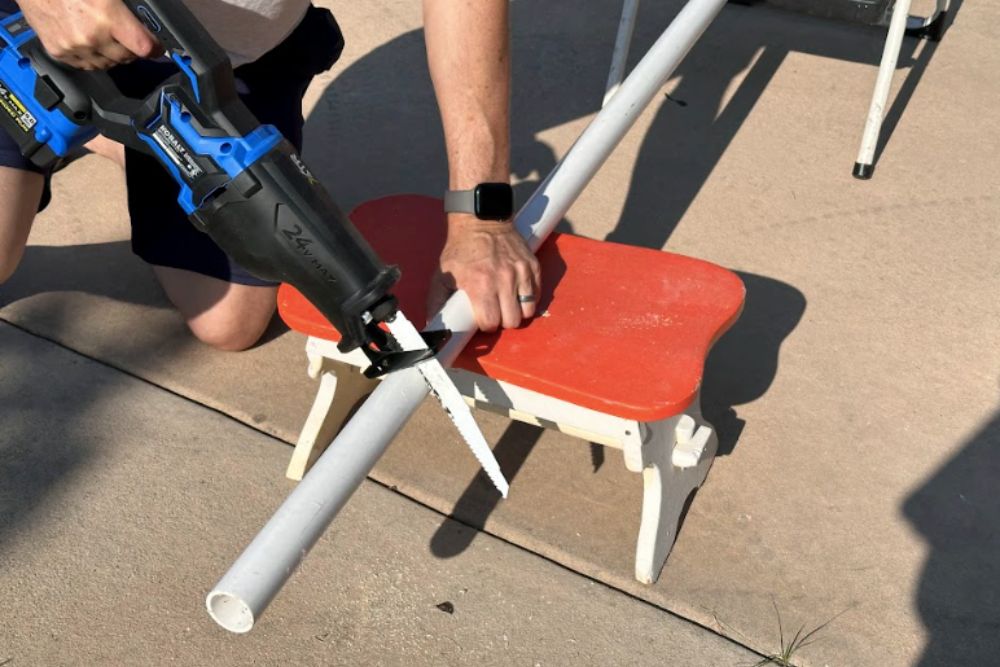
In addition to considering the type of material you’ll be cutting, a comfortable grip, blade movement, and maximum speed are some of the more important features to take into account when buying a reciprocating saw.
Stroke Length and Speed
Stroke length, the distance the saw blade travels with each stroke, and speed, which is measured in strokes per minute (SPM), largely determine how quickly a reciprocating saw can cut through a given material. Stroke lengths can vary from ⅝ inch to 1⅛ inches, and speeds typically range from 2,700 to 3,100 SPM. Recip saws with larger motors will generally have longer blades and faster blade speeds.
Variable-Speed Control
Some reciprocating saws have a speed adjustment dial that allows the user to operate the saw at different set speeds, but saw speeds are usually controlled by trigger pressure. This means the harder you pull the saw’s trigger, the faster the blade moves.
A variable-speed trigger is usually preferable to other types of speed adjustment because there’s no need to stop and start cutting just to change speeds. Seasoned construction workers often use very light pressure on the trigger when they start cutting (the slower the blade is moving, the less risk of kickback) and then increase pressure when the saw has already cut through a portion of the material.
Orbital Action
Some reciprocating saws feature orbital action, which means that in addition to moving in a push-pull motion, the blade also moves in a slight elliptical pattern. Orbital action increases the cutting speed of the saw, but it reduces accuracy.
A recip saw without orbital action will cut a straighter, cleaner line but will take longer to cut. Orbital action can be turned on when speed is desired, such as when the user is cutting through subflooring, and then turned off when a cleaner cut is desired, such as when trimming away small branches from a tree.
Blade Type
While reciprocating saws are mainly used for demolition purposes, construction materials vary, so you’ll find a variety of saw blades available. Most recip blades feature a universal shank, meaning no matter what type of blade you choose, it will fit your saw, no matter the brand. Some models also come with blade clamps that accommodate multiple positions, meaning you can saw upwards, downwards, or sideways.
Blades also come in a variety of lengths, from 4 inches to 12 inches, with 6 inches being the most common length. Match the following types of blades to the material you’ll be cutting.
- Wood: This blade is designed for sawing through plywood and dimensional lumber, as well as small tree branches (up to 2 inches in diameter). A wood blade features between 5 and 10 teeth per inch (TPI). Higher TPIs create a smoother cut, while lower TPIs are designed for speed but will leave jagged edges on the wood.
- Metal: A metal cutting blade features more teeth per inch, ranging from 10 to 24 TPI. The added teeth make it easier to cut through nails, pipes, and metal conduits.
- Demolition: A demo blade is often slightly thicker than other blades and is designed to saw through heavy-duty construction materials quickly. The TPI ranges from 6 to 11, and two different TPIs may be available on the same blade—one on the outer half and the other on the inner half—so that the user can move the saw closer or farther from the material for the quickest cuts.
- Combo: Like some demolition blades, a combo blade features two different TPIs and will be labeled as “5/10” or “6/10,” for example. If a combo blade is labeled as 6/10, the base half will feature 6 TPI for cutting quickly through plywood, while the outer half of the blade will feature 10 TPI for cutting through heavy nails. The user can adjust to the material being cut by simply using the appropriate part of the blade rather than needing to switch blades.
- Specialty: While the above four types of blades are the most common, specialty blades for specific purposes, such as pruning limbs, cutting through plaster, or even cutting through stone or ceramic tile, are available. These specialty blades come in a variety of TPI and are intended only for their labeled purpose.
Additional Features
Reciprocating saws also come with features designed to make them easier to use. Most have built-in work lights that help to illuminate whatever it is you’re cutting. Some reciprocating saws also have different blade positions that make it easier to cut horizontally. Most include a set of starter blades for cutting through various materials, including metal, plastic, and wood. Many also come with hard or soft carrying cases that make the saws easier to store and transport.
FAQs
Typically considered a demolition saw, a reciprocating saw can be a valued addition to the tool collections of professional builders as well as DIYers who work on their own remodeling projects. Below are some of the most common questions, and their answers, about these tools.
Yes. Reciprocating saw blades feature a universal shank that will fit most reciprocating saws.
Reciprocating saws can cut through relatively small branches, up to 2 inches in diameter, but the branch should be firm or the saw will shake it rather than cut through it.
Reciprocating saws are ideal in situations in which precision is not necessary, including demolition, pruning trees, cutting through pipes, or cutting through screws and nails. For projects that require more precision, go with a circular saw or table saw.
The simple answer is to choose a reciprocating saw that meets your needs. If you plan to use one only occasionally, then it makes more sense to go with a corded 12-amp model. For everyday use or large demolition projects, consider a cordless reciprocating saw capable of producing around 3,000 SPM with a stroke length of 1⅛ inches or a 15-amp corded model.
Meet the Tester
Tony Carrick is a freelance writer specializing in home improvement, landscaping, technology, home security, and design. Carrick has conducted rigorous product testing on everything from power tools to home security systems to backyard grills. With each review, his goal is to help readers determine whether a product meets their needs and if it is or isn’t worth its price tag.
Additional research provided by Glenda Taylor.
